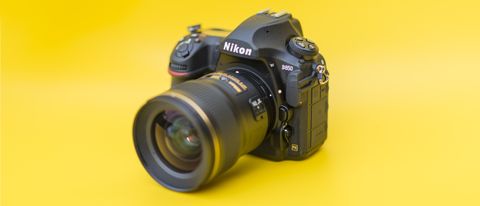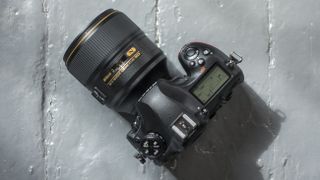Nikon D850
OUR VERDICT
Whether you're shooting weddings, landscapes, portraits, action or wildlife, the D850 won't leave you wanting. A much more versatile proposition than the D810 (and its closest rivals for that matter), the D850 is a brilliant DSLR, and perhaps the most well-rounded camera we've ever tested.
FOR
- Potential for large and detailed images
- Sophisticated and proven AF system
- Large and bright viewfinder
- 19.4MP DX crop mode
- Epic battery life
AGAINST
- More expensive than D810
- Live View focusing speed behind rivals
- SnapBridge still clunky
The Nikon D850 is finally here. After months of speculation, and Nikon itself teasing us back in July that the camera actually existed and was in development, the D850 has been officially announced – and boy, does it look like it's been worth the wait.
Superseding the brilliant 36.3MP D810 that's loved by both pros and enthusiasts alike, the D850 certainly has big shoes to fill. That said, while the D810 ticked a lot of boxes for photographers, its modest burst shooting speed of 5fps meant it wasn't the perfect all-round DSLR.
Nikon doesn't appear to be holding back with the D850, though, boosting numerous areas of the camera's performance to make it appear (on paper at least), the most well-rounded DSLRs we've seen. Is the D850, then, the ultimate DSLR?
Features
- Full-frame CMOS sensor, 45.4MP
- 3.2-inch tilt-angle touchscreen, 2,359,000 dots
- 4K video capture
While the D810 retained the same 36.3MP resolution as the groundbreaking Nikon D800/D800e, it's been eclipsed by both the 50.6MP Canon EOS 5DS and 42.2MP Sony Alpha A7R II. The D850, though, gets an all-new 45.4MP full-frame back-illuminated sensor (BSI), which is a hefty increase in pixels over the D810, and only marginally behind the 5DS.
Thanks to the light-collecting elements being closer to the surface of the sensor, the BSI design should deliver better low-light performance than previous sensors. Just as we've seen with the D810 (and D800e), the D850 forgoes an anti-aliasing filter, which means even more detail can be eked out of the sensor, although there is the added risk of moiré patterning.
On the occasions where you don't want (or need) to shoot at the D850's full resolution, there are two reduced size options, 25.6MP and 11.4MP, recording either raw or JPEG files. We can certainly see this feature appealing to news and sports shooters who'll want to transmit images as quickly a possible to picture desks, and might have otherwise passed up the D850 in favor of the 20.8MP Nikon D5.
Another trick up the D850's sleeve is the camera's DX Crop mode, in which the perimeter of the viewfinder is masked to provide a view equivalent to that of an APS-C-format DSLR. The resolution drops, as you're only using a portion of the sensor, but thanks to the D850's huge resolution you'll still be able to capture 19.4MP files – that's impressive stuff, and not far off the 20.9MP resolution of both the D500 or D7500. There's also a new 1:1 aspect ratio at 30.2MP.
Compared to the D500 (and, for that matter, the D5), the Nikon D850 has quite a modest ISO ceiling of 25,600, with a native base sensitivity of ISO64. This is no surprise really when you consider how densely populated the sensor is, but there is an extended sensitivity range up to an ISO equivalent of 108,400 (Hi2), while landscape photographers will be happy to learn that the D850 also has a Lo1 setting equivalent to ISO32.
The D850 sports a new 0.75x optical viewfinder – that's the largest magnification factor ever on an FX Nikon DSLR, and also a touch bigger than the 0.71x viewfinder on the 5DS. Unlike the D810, the D850 also features a tilt-angle, 3.2-inch 2,359,000-dot touchscreen. It's similar in spec to the one on the D500, but offers greater touch control, enabling you to navigate the menus as well as touch to focus, trigger the shutter and review images.
The D850 can shoot 4K UHD video in FX format with no sensor cropping at up to 30p, allowing you to take full advantage of the field of view of your lenses. Lower-resolution video modes are also available, including Full HD footage in 60p, while 4K UHD timelapse movies can be created in-camera.
If 4K timelapse footage isn't quite enough for you, the D850 can also create a full resolution time-lapse videos in third-party software thanks to the camera's built-in intervalometer – you can now create a new folder and reset the file numbering for each timelapse sequence, and avoid the rigmarole of stripping out the desired files yourself.
The D850 drops the CompactFlash card slot that was on the D810 in favor of an XQD slot
There's also an electronic Vibration Reduction system to reduce the impact of camera shake when shooting movies handheld, and there are ports for an external microphone and audio monitoring.
The D850 drops the CompactFlash card slot that was on the D810 in favor of an XQD slot and the performance advantages that brings (although at the moment Nikon is the only manufacturer to take up this storage format on its cameras), while the SD card slot supports cards up to UHS-II.
The D850 gets Nikon's SnapBridge connectivity for wireless transfer of images, which establishes a low-energy Bluetooth connection between the camera and your smart device. Images can then be transferred from camera to device via as you shoot at either 2MP or full resolution (though we'd avoid this with 45.4MP files), or individually if you select images on the camera. For speedier Wi-Fi transfers you can use the app to browse and select the images you desire.















